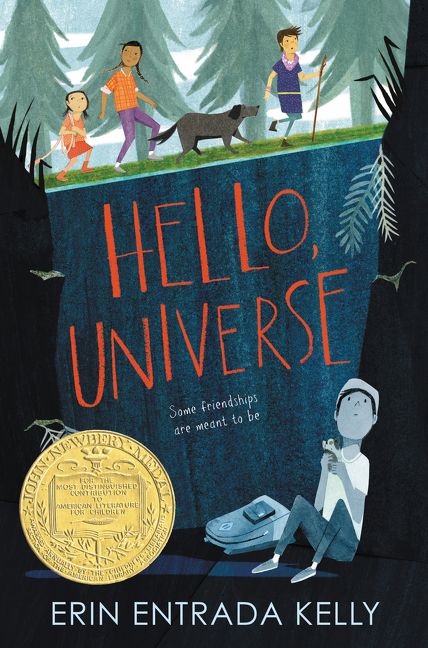In our group, LA Biscay is the structure master. She analyzes novel structure, scene structure, sentence structure, you name it. Here, she gives us insight into story structure through character arc, specifically how the character’s FEAR and the LIE they believe ties to two big plot moments. Part 1 of this series is excellent as well (there’s a link below), but this post stands on its own. Biscay offers tools and strategies for approaching your own novel and models how deep analysis can provide insight into your own work. –Anne-Marie
craft review by LA Biscay
In the first post of Structuring Story with Character Arc in Hello, Universe, we examined some early plot elements–the hook, the inciting incident, and the key event–and how those elements are tied to Virgil’s Lie (or Belief that Must Be Changed) and Fear, through the lens of K.M. Weiland’s series on story structure and character arc. The Character Arc in the early part of the book drives the Story Structure.
The Role of Fear
The bulk of Virgil’s story details him facing his fears, making decisions in spite of his fears, and learning to understand his fears. Kelly sets up his primary fear, FEAR OF THE DARK, late in the first Act, and reinforces the fear as the novel continues.
Virgil confesses to the reader:
“His second most confidential piece of information: he was afraid of the dark. Yes, he was eleven and shouldn’t be afraid anymore, but he couldn’t help it. Maybe it was the tales Lola told him about evil three-headed monkeys that thrived in the darkness, or her stories of bad children who were plucked up by birds in the dead of night. Darkness was a sightless beast, as far as Virgil was concerned.” (p. 44)
At the well’s edge, Virgil thinks:
“Even though it was a bright sunny afternoon aboveground, the deep well that now cradled Gulliver was a dark, dark place. And darkness was darkness, whether it was in the sky or not.” (p. 121)
But Virgil’s love for Gulliver is greater than his fear of the dark, and greater than his desire to get to Kaori’s house, so he descends down the ladder and into the well. With that one decision, Virgil has his first success by facing a fear, and now he is on his way to overcoming the Belief/Lie that he is a failure.
If you’re following along in your book, you’ve noted a percentage misstep: Gulliver and the backpack land in the well around 38% of the novel. So did Kelly miss her story structure marks, or did I assign the wrong event as the 1st Plot Point? Well, Kelly also needs to set up the parallel story of Valencia and introduce both the subplot characters (who are essential to the story). And as it is, Virgil is by himself in the well for 160 pages. I think elongating the First Act is a good choice to cover the ground she needs to and to minimize Virgil’s time in the well.
So, learning from Kelly, as long as you have built in a life-altering event somewhere in the first third of your story—and it’s something to which your protagonist must strongly react—you’re on the right track!
Curiously, what does fall smack at the 25% mark of Hello, Universe, is a scene that highlights the novel’s theme and also offers some foreshadowing. In Chapter 11, Virgil and his grandmother, Lola, discuss fate, something Virgil wants to believe in, but he questions whether life may be a string of coincidences. Lola says she most certainly believes in fate.
“I think good things happen for a reason. And bad things, too…. If you didn’t have bad things you wouldn’t have good things. They would all just be things.” (p. 83)
Then she predicts a bad thing (the 1st Plot Point) and warns Virgil to “beware the color red.” (p.84) We know something’s coming!
Once Virgil is trapped at the bottom of the well with no cell phone, he goes on a reflective journey of what he really NEEDS and how he must overcome his LIE in order to attain it. But he encounters two main setbacks.
Action: What is the first life-altering event to which your protagonist must strongly react?
Setbacks: the Midpoint and All is Lost

At the Midpoint moment, Valencia replaces the cover on the well, not knowing Virgil is trapped inside. It’s masterfully structured, because not only have the plot lines of our two main characters collided (yes!), it requires an immediate and definitive response from Virgil: he has an anxiety attack. (I would, too.) Once he recovers, he enlists the help of Ruby, a character from one of Lola’s stories. Depending which side of the theme you believe, Ruby either springs from Virgil’s imagination or is the universe sending him a spiritual guide. Together, the two begin to figure out that Virgil can be the hero of his own story.
But not yet. He must hit the lowest of low points at the end of the Second Act (around 75% of the novel). Weiland writes, “Metaphorically, this moment is a representation of the character’s dying to his old self….[it] will often feature actual death, either literally or symbolically.” (Part 12)
By this point, Virgil has tried everything: jumping for the ladder, climbing up the stones, yelling, yelling some more, and even sending out telepathic messages through the universe to his family. All is lost. Virgil and Gulliver will die in the well.
Fortunately, neither one physically dies. But the old Virgil does.
“He didn’t want to fall asleep thinking about all the ways he’d failed in life, so he decided to imagine what he’d do differently if he was ever rescued.” (p.274)
And guess what? He creates a list all the things he NEEDS in order to overcome the Lie/Belief. When he is finally saved from the well—by Valencia of Spain, who is not afraid of the dark and enjoys exploring caves—he is ready to tackle that list. Sort of.
Action: What is it your character needs? How will getting what they need enable them to conquer the Lie in the climactic moment of the story?
The Climax
Of the story’s Climax, Weiland writes, “Your story may have two climaxes, in which a faux climax leads up to the climax proper, depending on how many layers of conflict you’ve created. Give yourself permission to cut loose with your climax.” (Structure, Part 10)
Kelly weaves together so many layers in Hello, Universe, I’d say she cut loose.
The faux climax is FINALLY getting Virgil out of that well. The climax proper happens over several scenes and deals with Virgil’s Lie and if he will EVER overcome it. With great story telling flair, Kelly pulls Virgil from the well, but lets him fail one more time. He can’t even muster a “thank you” to Valencia.
But he can and does stand up to Chet, with the help of Sacred, the dog, because you know, Chet’s greatest fear is big dogs. And Virgil stands up to his mom, with the help of Lola. He tells his mom she can’t call him Turtle anymore, but she can call him any number of names, including bayani, which means hero.
Kelly waits for the last, single word of the entire book to answer the story question she set up at the beginning of the novel. Through Virgil’s descent and rebirth from the well, he’s learned that he can be true to his introverted self while speaking up at the same time. In the words of Ruby, or maybe Lola, or perhaps God, or the Great Spirit, or maybe the Universe itself, Virgil knows the truth: “It doesn’t take many words to turn your life around.” (p.302)
Takeaways
I love studying story structure, and Weiland’s connection between Character Arc and Story Structure is a helpful tool in creating great story bones. Hello, Universe turned out to be a strong study in connecting the two. Kelly also adjusts the “rules” of plotting to match the needs of her story–something that helps me not hew too closely to the requirements if my story needs something slightly different.
In your story, consider how your character’s Lie and Fear impact the plot. And look to the Midpoint and All is Lost moments to ratchet up the stakes for your character. See how the climax resolves both the plot problem (what the character wants) and the Lie (what the character needs to change).
Here’s a challenge: take one of your favorite books and analyze it according to Character Arc and Story Structure. You’re sure to learn new tricks and skills you can take back to your own writing.
LA Biscay writes children’s books and dances everyday, if only down the hall. As a teacher of Creative Movement, she enjoys assembling basic dance elements into unique combinations. It’s probably why she’s a fan of story structure! LA is an active member of SCBWI. She lives in the San Francisco Bay Area with her husband, children, super dog, and a brood of chickens that lay green eggs. Yep. Green eggs.


COMMENTs:
0